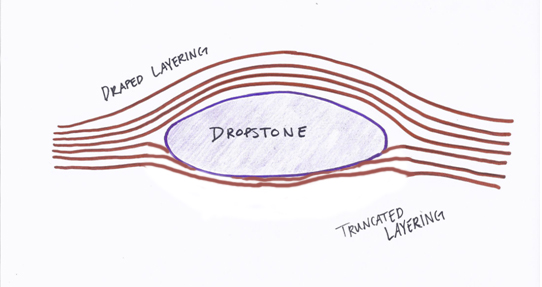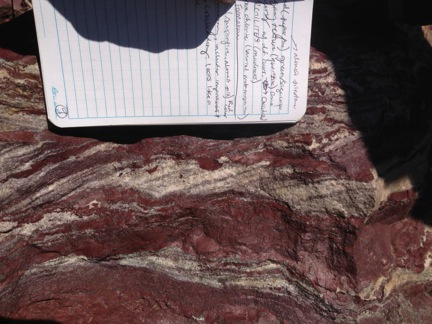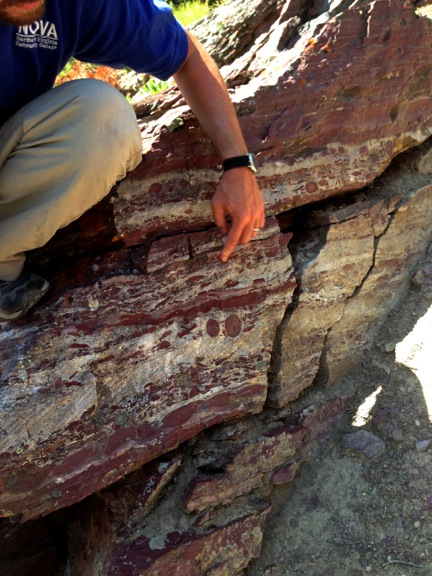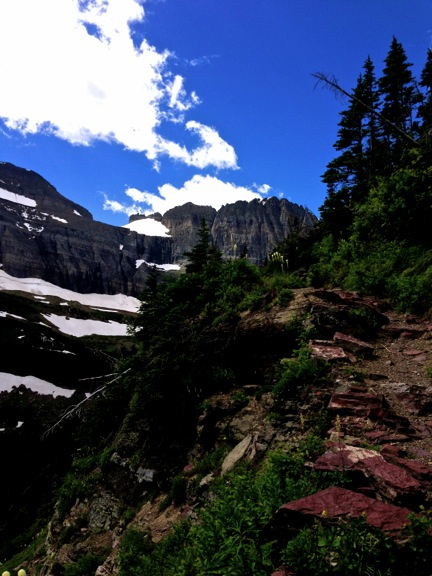This is the first of several guest posts that will appear here this week, all written by students who participated in this past summer’s Regional Field Geology of the Northern Rocky Mountains course.
by Madeleine Rushing
Northern Virginia Community College
Sedimentary deposition typically is seen as horizontal strata, layered one on top of the other with oldest deposits on the bottom, getting progressively younger with each layer. Which makes sense, as that is how gravity operates.
Let’s take ourselves to Looking Glass Hill Road (Route 49), northwest of East Glacier Village, Montana.
Found here:

Our location is along the top curve of the “S” portion of the road in the center of the map. Here’s a closer view:

This deposit has vertical beds!

Use of Sean and Pete as Scale:

As you can see, the outcrop exhibits a variety of poorly sorted stones; there is fine sediment, pebbles, gravel, clasts, cobbles, etc. This outcrop is fairly young, as it contains a matrix that is hardly lithified.
Take a look at the ultra fine-grained silt or “glacial flour” in my hand below:

What happened here was that an advancing glacier deposited an end, or terminal moraine (not seen in any picture above), which is a ridge of till that formed along the leading edge of the furthest advance of the glacier. The glacier receded, opening an area for a lake to form between the moraine and the glacier itself, which, over time, allowed for sediments such as silt to be settled out at the bottom of the lake.
As the glacier continued receding, gravel outwash was deposited along the edge of the glacier and into the lake. Also during this time, icebergs broke off from the glacier, carrying with them, rocks compacted within the ice of the glacier. The icebergs carried these rocks and dropped them into the lake’s bed during deposition of lake sediments, causing “dropstones”.

A dropstone, which is seen above, is a stone deposited by an iceberg with draped layering above and truncated layering below. The truncated layering exists from the dropstone being dropped onto previously deposited sediments; those sediments beneath the stone are slightly pressed down due to the weight of the stone. Deposition continues, “draping” atop the stone, causing the draped layers above of the stone.

The glacier then advanced again, pushing and forcing the lake’s sediments along the way, causing them to plunge upwards. A similar event to think of to perhaps help visualize this process would be to imagine the palm of your hand facing out towards a layered cake. Your hand would push the layers upward and on top of each other.
The glacier receded once more, finally melting away, leaving the vertical beds of glaciofluvial and glaciolacustine sediments that we find on route 49 today.
Looking at the outcrop, you will find vertical, dark strands that vary with their thickness; they may resemble similar shapes to flames. These are called flame structures, and are made up of the gravel outwash that had been deposited into the lake by the glacier.
A flame structure is a soft sediment deformation that forms in unlithified sediments. The weight of an overlying bed forces an underlying bed to push up through the overlying bed’s sediments, generally when both strata are saturated with water. In order for this to occur, the overlying bed must be of a higher density, or differential pressures then the underlying bed. Think of pressing your hand down on silly putty; the putty would push up through your finger due to your hand being of higher density and the exertion of pressure. The shape that the putty would make would be quite similar to that of a flame structure that you see in the outcrop.
Here’s another look:

This glaciofluvial structure is composed of a variety of rocks commonly found inside Glacier National Park. The majority of the rocks within this structure are red and green argillites. An argillite is a fine-grained sedimentary rock that is composed of lithfied mud. Both red and green stones in the outcrop are argillites, however they come from two different formations, the Appekunny and the Grinnell; both of which range between 1.4 billion to 800 million years in age.

The Appekunny Formation is a 600m thick rock strata of this green argillite shown above, that is located within the Lewis range of Montana. The argillite gets its green color from the presence of chlorite due to burial metamorphism. Looking at the Appekunny formation, it is likely that one will find layers of oxidized iron content (shown in the rock on the left) and white quartzite strands within the argillite rocks (shown in the rock on the right). Mudcracks are also commonly found in the Appekunny argillite.

The Grinnell formation is the red argillite shown above. The Grinnell gets its red color from high oxidation levels, much higher than that of the Appekunny. The Grinnell was deposited in shallower environmental conditions than the Appekunny and therefore, higher energy as well. However, similar to the Appekunny, the Grinnell features strands of white quartzite as seen above. Note the crossbedding in the quartzite layer in the middle that indicates the higher energy environment.
Sedimentary structures including mudcracks, raindrop impressions, and ripple marks are all also commonly found in rocks from the Grinnell Formation. Raindrop impressions and mudcracks are seen in the picture below (raindrop impressions on the left and faint mudcracks on the right).

The Grinnell also shows up in mudchips found in some rocks throughout Glacier National Park. These mudchips form from “blobs” of clay dropping into the layer of strata beneath while it is still in a liquid or “sluggish” state, resulting in flocculated platelets of clay within the quartzite layer.

Both the Grinnell and Appekunny formations are seen throughout Glacier National Park. In fact, the Grinnell Formation “paves” the Grinnell Glacier trail for a good distance as seen below:

These two argillites are very important throughout Glacier National Park and they are the predominate stones in our glacial depositional structure. Knowing these two formations are found within the vertical beds of fluvioglacial sediments, we can age this structure relatively young in relation to the Appekunny and Grinnell formations. This also corresponds with the initial impression that it is a young structure based off of the lithification factor.
Geomorphic processes form the spectacular glacial structures throughout Glacier National Park. They are quintessential examples of glacial geomorphic features and landforms and therefore an ideal location to study. It is great to be able to look at these landforms and determine what originated them to form, the environments they withstood, and events they underwent. I look forward to being able to use this obtained knowledge in the future for research and study as well as the simple pleasure I get from observing a geologic area and being able to hypothesize the process of its formation.

Were there any bulk densities measured? I do research in alpine catchments on soil erosion and have incredibly high densities in the soils as they were compacted by the weight of the ice…
The texture and consistency of the fine glacial sediments reminded me of baking soda or all purpose baking flour if that helps. The outcrop itself was highly compacted, but the sediment could be scraped off the wall or broken down rather easily. I have not personally measured any of my collections from the site however, it would not be difficult to do so.